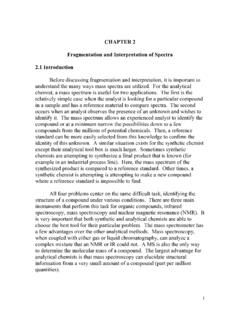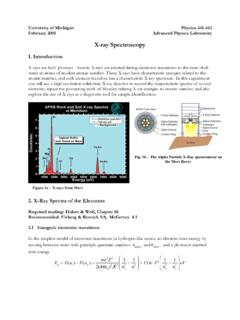Chapter 13 Spectroscopy
Found 5 free book(s)RAMAN SPECTROSCOPY OF GRAPHENE AND RELATED …
www.physics.purdue.eduThis chapter is a review of the application of Raman spectroscopy in characterizing the properties of graphene, both exfoliated and synthesized, ... 13]. A comparison of the Raman spectra of single-layer graphene and bulk graphite (A-B stacked) can be seen in Fig. 2(a).
CHAPTER 2 Fragmentation and Interpretation of Spectra 2.1 ...
www.whitman.eduAfter choosing to use mass spectroscopy, the selection of gas chromatography or liquid chromatography is equally important. Gas chromatography is utilized for volatile and thermally stable compounds (up to 300 °C). Liquid chromatography is usually utilized for all other compounds since it has poorer resolution than GC. As a result, this chapter
X-ray Spectroscopy - University of Michigan
instructor.physics.lsa.umich.eduX-ray Spectroscopy 1. Introduction X-rays are KeV photons. Atomic X-rays are emitted during electronic transitions to the inner shell states in atoms of modest atomic number. These X-rays have characteristic energies related to the atomic number, and each element therefore has a characteristic X-ray spectrum. In this experiment
Impedance Basics - Clean Energy Institute
www.cei.washington.eduElectrochemical Impedance Spectroscopy (EIS) is a frequency domain measurement made by applying a sinusoidal perturbation, often a voltage, to a system. The impedance at a given frequency is related to processes occurring at timescales of the inverse frequency (e.g. f=10 Hz, t=0.1 s). Although many other electrochemical measurements focus on ...
Solvent-Free Aldol Condensation Reactions: Synthesis of ...
www.rsc.orgIn the 13C NMR spectra the signal due to the carbonyl group carbon (C-1) is also characteristic of these compounds (δ 190-195 ppm). The deshielding effect of the carbonyl group in the proton and carbon resonances of the A and B rings and also in the β–position of the α,β-unsaturated system can also be explored in the 1H and 13C NMR




